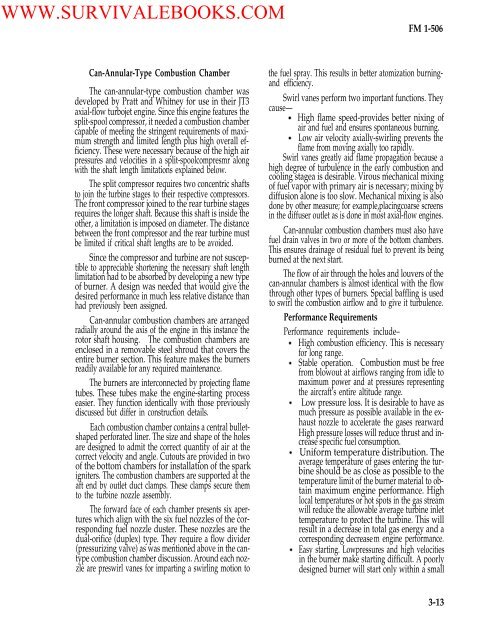FM 1-506 Fundamentals of Aircraft Power Plants ... - Survival Books
FM 1-506 Fundamentals of Aircraft Power Plants ... - Survival Books
FM 1-506 Fundamentals of Aircraft Power Plants ... - Survival Books
You also want an ePaper? Increase the reach of your titles
YUMPU automatically turns print PDFs into web optimized ePapers that Google loves.
WWW.SURVIVALEBOOKS.COM<strong>FM</strong> 1-<strong>506</strong>Can-Annular-Type Combustion ChamberThe can-annular-type combustion chamber wasdeveloped by Pratt and Whitney for use in their JT3axial-flow turbojet engine. Since this engine features thesplit-spool compressor, it needed a combustion chambercapable <strong>of</strong> meeting the stringent requirements <strong>of</strong> maximumstrength and limited length plus high overall efficiency.These were necessary because <strong>of</strong> the high airpressures and velocities in a split-spoolcompresmr alongwith the shaft length limitations explained below.The split compressor requires two concentric shaftsto join the turbine stages to their respective compressors.The front compressor joined to the rear turbine stagesrequires the longer shaft. Because this shaft is inside theother, a limitation is imposed on diameter. The distancebetween the front compressor and the rear turbine mustbe limited if critical shaft lengths are to be avoided.Since the compressor and turbine are not susceptibleto appreciable shortening the necessary shaft lengthlimitation had to be absorbed by developing a new type<strong>of</strong> burner. A design was needed that would give thedesired performance in much less relative distance thanhad previously been assigned.Can-annular combustion chambers are arrangedradially around the axis <strong>of</strong> the engine in this instance therotor shaft housing. The combustion chambers areenclosed in a removable steel shroud that covers theentire burner section. This feature makes the burnersreadily available for any required maintenance.The burners are interconnected by projecting flametubes. These tubes make the engine-starting processeasier. They function identically with those previouslydiscussed but differ in construction details.Each combustion chamber contains a central bulletshapedperforated liner. The size and shape <strong>of</strong> the holesare designed to admit the correct quantity <strong>of</strong> air at thecorrect velocity and angle. Cutouts are provided in two<strong>of</strong> the bottom chambers for installation <strong>of</strong> the sparkigniters. The combustion chambers are supported at theaft end by outlet duct clamps. These clamps secure themto the turbine nozzle assembly.The forward face <strong>of</strong> each chamber presents six apertureswhich align with the six fuel nozzles <strong>of</strong> the correspondingfuel nozzle duster. These nozzles are thedual-orifice (duplex) type. They require a flow divider(pressurizing valve) as was mentioned above in the cantypecombustion chamber discussion. Around each nozzleare preswirl vanes for imparting a swirling motion tothe fuel spray. This results in better atomization burningandefficiency.Swirl vanes perform two important functions. Theycause—High flame speed-provides better nixing <strong>of</strong>air and fuel and ensures spontaneous burning.Low air velocity axially-swirling prevents theflame from moving axially too rapidly.Swirl vanes greatly aid flame propagation because ahigh degree <strong>of</strong> turbulence in the early combustion andcooling stagea is desirable. Virous mechanical mixing<strong>of</strong> fuel vapor with primary air is necessary; mixing bydiffusion alone is too slow. Mechanical mixing is alsodone by other measure; for example,placingcoarse screensin the diffuser outlet as is done in most axial-flow engines.Can-annular combustion chambers must also havefuel drain valves in two or more <strong>of</strong> the bottom chambers.This ensures drainage <strong>of</strong> residual fuel to prevent its beingburned at the next start.The flow <strong>of</strong> air through the holes and louvers <strong>of</strong> thecan-annular chambers is almost identical with the flowthrough other types <strong>of</strong> burners. Special baffling is usedto swirl the combustion airflow and to give it turbulence.Performance RequirementsPerformance requirements include–High combustion efficiency. This is necessaryfor long range.Stable operation. Combustion must be freefrom blowout at airflows ranging from idle tomaximum power and at pressures representingthe aircraft’s entire altitude range.Low pressure loss. It is desirable to have asmuch pressure as possible available in the exhaustnozzle to accelerate the gases rearwardHigh pressure losses will reduce thrust and increasespecific fuel consumption.Uniform temperature distribution. Theaverage temperature <strong>of</strong> gases entering the turbineshould be as close as possible to thetemperature limit <strong>of</strong> the burner material to obtainmaximum engine performance. Highlocal temperatures or hot spots in the gas streamwill reduce the allowable average turbine inlettemperature to protect the turbine. This willresult in a decrease in total gas energy and acorresponding decrease m engine performance.Easy starting. Lowpressures and high velocitiesin the burner make starting difficult. A poorlydesigned burner will start only within a small3-13
















